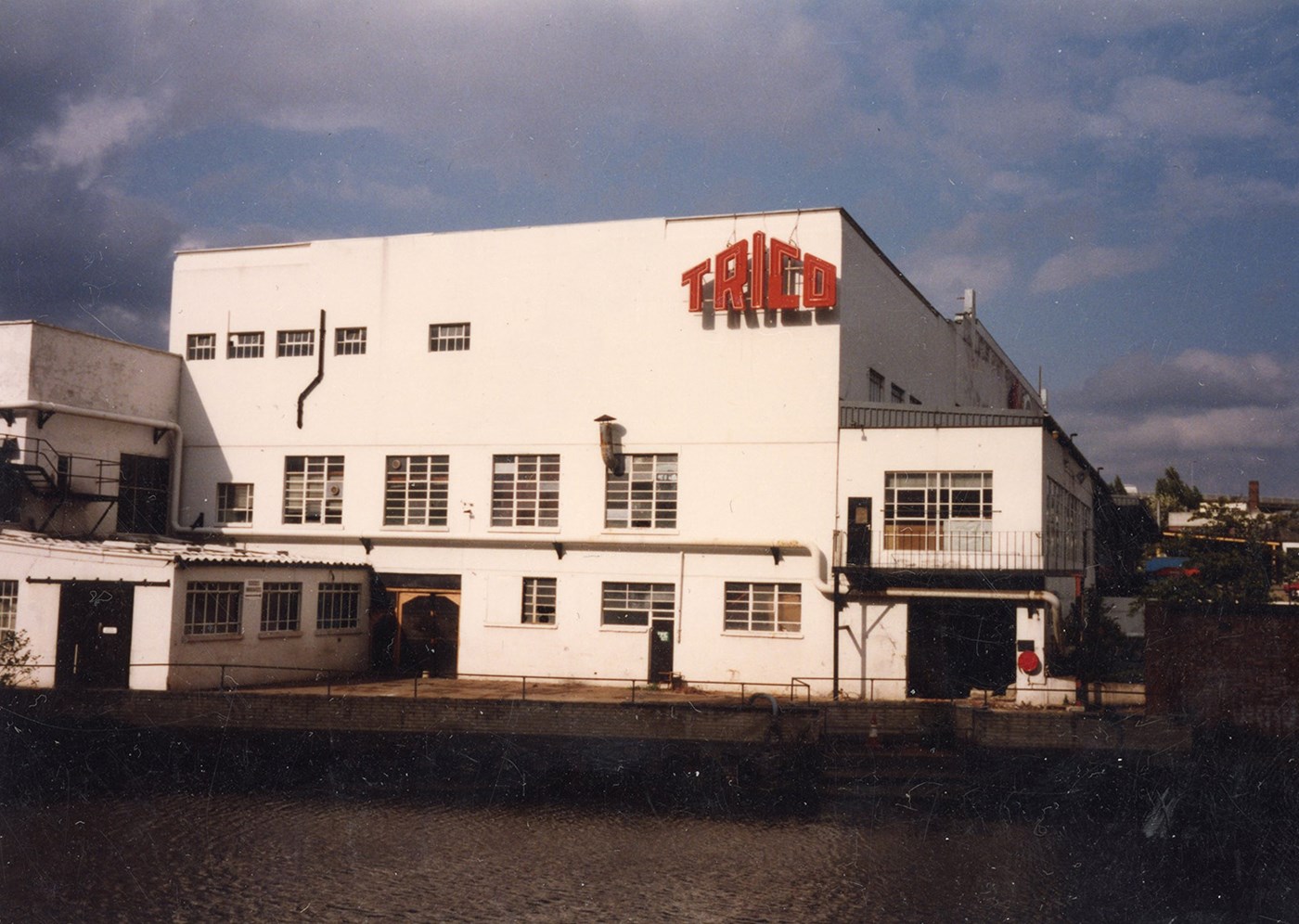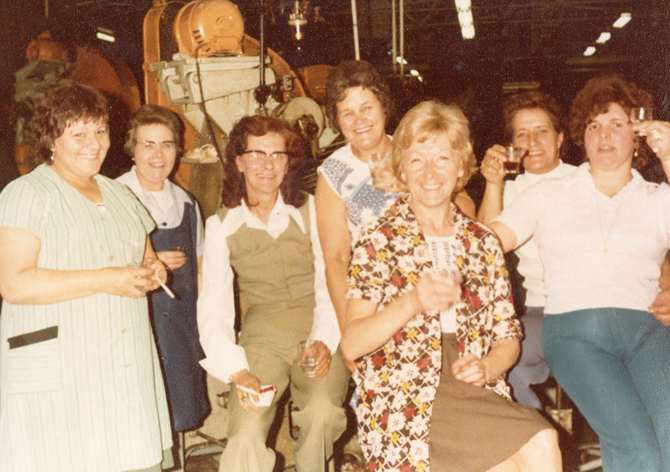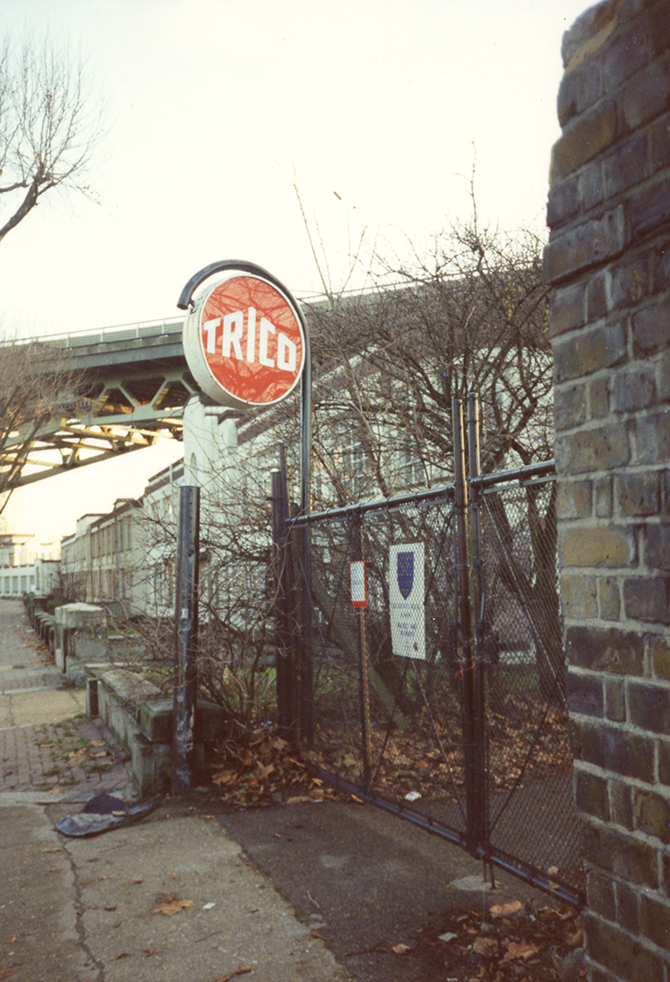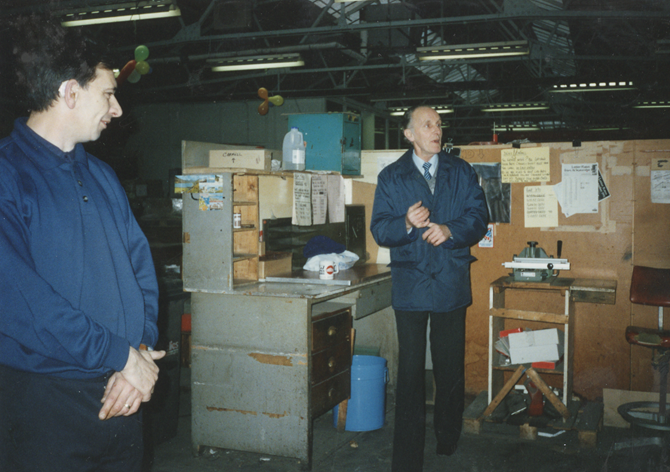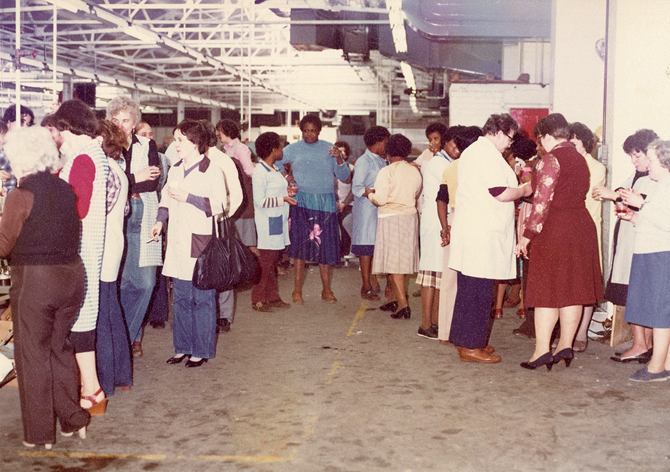Trico Factory
Click here for further readingTrico Folberth Ltd was an American windscreen wiper manufacturer that opened a factory on the Great West Road in 1928. The factory included a mixture of office and floor workers. The floor workers described the factory as a large space where you could see different departments on the same floor. During the summer, the factory was incredibly hot and, in the winter, incredibly cold. With large machinery the factory floor was a noisy environment with staff at work 24 hours a day.
The factory in the 1970s was a diverse environment much like West London at the time with migrants from various backgrounds.
“Companies started organising these huge convoys to break through the picket line, to try and keep production going and to demoralise us as well. Very American style, it being an American company, of course”
Monica Fontaine-Alexander former employee, on working conditions
Audio transcript
You had to do your work nobody can help you, you have to work for yourself and then everybody do their work. Nobody helps anybody, that was one of the rules. If you have to go to the toilet you don’t have to ask, you can go to the toilet and come back, because you’re working piece work, so if you want to go to the toilet and stay there that’s your problem as your work is not doing - you’re not doing any work.
Q: Were you allowed to talk to the people around you?
Yes, yes, because you’re working like, one behind the other, you see, that person was here and you’re in front of that person and that person is your friend, of course you can talk and talk and talk.
Inside the Trico Factory
Start of the strike
In 1976 the women who worked on the production line on the day shift realised they were paid less than men working on the night shift. In 1975 the men received an extra 1/3 night shift premium and a higher piece rate of 36.7p per hour compared to the women’s rate of 29.2p per hour.
Trico decided to end the night shift on the production line. Most of the men took voluntary redundancy but five men opted to transfer to the day shift. It was agreed that they would not receive the night shift premium but would keep their enhanced piecework rate which would see them getting around £6.50 a week more than the women for doing the same work. The women on the day shift argued they deserved the same piece rate as the men.
The Equal Pay Act (EPA) was passed in 1970 and employers were given until the end of December 1975 to implement its provisions. In the summer of 1975 negotiations were started by the Amalgamated Union of Engineering Workers (AUEW) at the Trico factory to ensure that when the EPA came into force there would be a common operational pay rate for men and women.
The Company argued that the men were being paid more because they were more flexible in terms of their working hours. However, the Union argued against this as, since 1969, the women had been covered by a flexibility agreement which they had signed in exchange for a very small pay rise. By December the issue was still unresolved. Management then proposed that they would give future pay increases to women only, until they caught up with the men’s rate of pay. This did not meet the women's demands and would also have a detrimental impact on the men who would not receive a pay rise.
On 24 May 1976 there was a mass union meeting of the Trico workers in nearby Boston Manor Park. At the end of the meeting the women stayed behind for an update on the equal pay negotiations. The union officials informed them that formal negotiations had come to an end with no satisfactory resolution, and it was up to the members what they wanted to do next. All 400 production line workers, mostly women, went on strike and 98 women who had not been union members joined.
“We’re looking at the pay slips one day and somebody says, ‘Oh, gosh, you’ve got a lot of money, what have you been doing, overtime?’ And we said, ‘No, standard week, you know, same as you’re doing’. And then this was when the realisation came up that in fact we were getting paid a better rate of money than they [the women] were for doing the same job”
Sally Groves, former employee, on the strike
Audio transcript
The first proposal put was for all out strike action, because that’s what those women wanted, and it was carried overwhelmingly. So we were all dazed and we went back into the factory thinking, ‘Hang on, we’ve just voted to go on strike, all out strike, not just for a day or whatever.’ And people going, ‘Oh, goodness’. And I remember that day, because we went back and people — and the guys who were all, one or two had stayed for that meeting but most were in the factory, they said, ‘What’s happened, What’s happened?’ And so we’re saying, ‘Well, we’re on strike!’ 'Okay, on strike!’ And then there was the issue, ‘Oh, so we don’t go back to work, we’re already on strike,’ and I remember someone saying to me, I mean I was fairly new, I’d only come the previous year, saying, ‘Do we clock out?’ I don’t know, you know! Little did we know, because people did then clock out before they left the factory and they had to pick up their things from their lockers and their belongings, little did we know that when we did clock out, we thought it might be a few days, that it would be 21 weeks before we came back in. And the guys couldn’t believe it, you know, but nor could we. So that’s how that started and it, it, had the most incredible effect, you know, on not only the whole factory but also us women too.
Inside the Trico Factory
The picket line
A picket line was set up and on 27 May the workers organised their first march around Brentford to publicise their campaign. That day the local AEUW district committee endorsed the strike. The National Executive Council of the Union declared the strike official shortly after on 15 June. Before this the majority of other workers in the factory had voted against joining the strike. Once it was made official 150 men, mainly from the tool room, joined the strike. The Union paid the strikers £9 a week strike pay, to be collected outside the Griffin pub.
News of the strike spread and on 29 June the women held another march around Brentford, inviting local factories to send delegations. Nearly 500 people joined the march including workers from Acton Rails, AEC (Associated Equipment Company), Magnatex, British Airways, Glacier Metals, EMI, Ranton Plastics, Hounslow, Ealing & Brent Trades Councils.
The company tried to keep up production using the few workers who returned, transferring other workers in the factory to different jobs and taking on a few extra recruits. To avoid union action, supplies were sent in through small freighting companies in unmarked boxes. Finished goods were smuggled out in the cars of managers and sales reps. However, finished work was accumulating and the factory was short of sheet metal.
The picket line had been effective at dissuading deliveries and collections during the day. So, on 1 July a convoy of nine large lorries and private cars arrived at the picket line at 2am. There were only four pickets on duty, but they managed to send away six of the lorries. The next night the trucks returned, accompanied by extra police. They arrived at such high speed the pickets had to leap out of their way.
The burden of picketing fell on 50 - 60 people. More pickets were needed at night so a decision was made to pay an allowance to those picketing at night to encourage more to volunteer. The Southall District Committee also called on members in local factories to ‘adopt a night’ to picket. A list was also drawn up of over 100 volunteers (strikers, trade unionists and women’s movement activists) who could be called on for emergency picketing. Local trade unionists were also supporting the strike by refusing to handle Trico goods, making donations, and visiting the picket line.
At 1am on 11 July, 17 lorries and 15 private cars took the pickets by surprise. The vehicles had a police escort and the police had also closed off Boston Manor Road to allow the traffic to speed past the pickets. Between each truck were carloads of strike breakers driven in to unload the lorries. They stayed until 4am and the police used their cars to create a path through which the lorries and cars could leave. Police officers turned a blind eye to cars concealing their number plates and speeding through red lights.
The police worked to minimise the amount of people on the picket line and strikers reported incidents of police aggression. On 29 July, police dragged away both protesters and TV crew insisting only six people were allowed in the picket.
Phyllis Green, former employee, on the picket line
Audio transcript
Q: And what was it like on the picket line?
A: It was good fun. Great fun. And you’d get tea and biscuits and people would bring sandwiches in and fruit. So you didn’t really have to worry too much about eating. And then I used to get, I think it was 50p a day for picketing, for the whole day. So that came in extra. I thought that was a lot of money then, but my grandchildren wouldn’t think that now!
Q: Who was paying you the 50p?
A: The union.
Inside the Trico Factory
Community Support
The protest received widespread support from the local community and other local factory workers.
Delegations were sent all over the country (including Newcastle, Manchester, Glasgow and Sheffield) to raise support and donations from women’s groups, trades unionists and left-wing groups, and to lobby organisations to boycott Trico wipers and blades. On 2 August at Southall District AUEW’s 16,000 members voted in favour of a 5p levy to support the strikers. There was a weekly collection at the neighbouring Firestone factory. Gurdwara (Sikh temples_ around Southall raised considerable sums. The Young Liberals and Young Socialists raised money at their conferences. In total the strikers raised £34,644 (including £6,822 from the Southall District levy), the equivalent of about £262,000 today. The vast majority of this sum was from ordinary working people who believed in their fight. There were many groups who joined the marches and picket line throughout the strike such as pensioners, students, and the Gay Socialist Group.
Sally Groves, former employee, on community support
Audio transcript
And we even had come and support us, the, they called themselves the Gay Socialists, and this is interesting because they came down, and they had a particular night, and I know we were told more latterly, you remember there was the film Pride, and the gays and lesbians supporting the miners and some people think that was the first time that the gay community had really supported sort of some trade union, unionists and that, but that wasn’t the first time because I can vouch that in ’76 the Gay Socialists came down and supported us!
“And then you used to have people just used to come and sit with you, you know, old people used to bring you tea bags round and biscuits. Macfarlane’s used to be up Commerce Road, up by Gillette’s, and they used to bring down a load of old broken biscuits and things like that, you know. People were very, very good. ”
Inside the Trico Factory
Return to work
On Thursday 14 October the final meeting took place. The Engineering Employers’ Federation arranged a meeting of Trico management with AEUW at the Heathrow Hotel. The Company agreed to meet the women’s demands. The next day, a victory meeting was held at St Faith’s Church Hall in Brentford. The following days the women and all those included in the strike celebrated their victory. The Trico Equal Pay Strike become the longest strike and most successful in the history of the campaign for equal pay.
On 18 October, the strikers were scheduled to return to work where many celebrated and a victory march was organised. Although, it was a mostly celebratory time, there was also hostility towards the strikers when they returned from those who did not agree with or support the strike.
Phyllis Green, former employee on the 'victory'
Audio transcript
Q: How did you feel when the strike met the aims?
A: Oh, we were all elated. We were delighted. We just wouldn’t have went back without…well I never got actually equal pay after all that. But everyone, the ladies just wouldn’t have went back and the men who supported them wouldn’t have went back until they got equal pay. And the men who came off the night shift to support us, it wouldn’t have been right either to let them down, so that was good. I only got £2.50 rise because they argued that where I worked in the shipping factory, the men was doing pallets. They’d do the big pallets for Ford’s factories and stuff like that. But then when there was a rush on they didn’t mind asking us to do the pallets like, you know. We were only supposed to only do post or parcels of a certain size, but when there’d be a big rush on everyone just dumped in and we done pallets loads of times. But they argued that that was a man’s job and we wouldn’t be fit to do the pallets so we got a rise of £2.50 because everybody got a rise as well as equal pay in the factory.
Robert Singh, former employee on returning to work
Audio transcript
I should say that when I went back in to my department with my friend it was very hostile, and I can remember one day soon after this, going into where we had the toilets and, written on the wall, was a great big thing that says, ‘Bob Singh, you black, commie bastard’. Oh yes. In big letters. Didn’t faze me.
Inside the Trico Factory
Closure
In August 1991 Trico Folberth announced they would be closing their factory in Brentford by the end of 1992.
This would mean the loss of 800 jobs with many employees having worked there for 20 to 30 of the 60 years the factory had operated on the site. The main union, AEU, said the announcement had come out of the blue.

